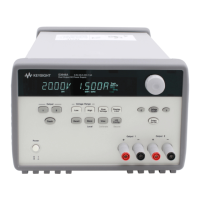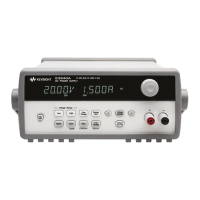Sharing Deviation for Units of Equal Power (either 1 kW or 2 kW)
The following table gives the Gain and Offset values for paralleled units of equal power:
Paralleled Units (N
T
) Gain Error % (G) Offset Error % (K) Gain and OffsetEquations
2 0.200 0.6 G = 0.4%((N
T
– 1)/N
T
)
K = 0.6%(N
T
– 1)
3 0.267 1.2
4 0.300 1.8
5 0.320 2.4
Example (60 A load current) You have three 1 kW, 40 V, 25 A units connected in parallel drawing a
total load current of 60 A. Using the gain and offset values from the above table (G=0.267%; K=1.2%),
the worst-case deviation from the ideal current sharing contribution of 20 A for an individual unit would
be as follows:
∆I
OUT(WORST_CASE)
=±G(I
OUT(IDEAL)
) ±K(I
RATING
)
∆I
OUT(WORST_CASE)
=±0.267%(20A) ±1.2%(25A)
∆I
OUT(WORST_CASE)
=±0.353A
Note that the percent of deviation from the ideal becomes greater for smaller output currents,
because the offset error predominates. This holds true all the way down to zero current. If, in the
above example, the paralleled units were drawing no current (0 A) , the worst case deviation would
still be:
∆I
OUT(WORST_CASE)
=±0.267%(0A) ±1.2%(25A)
∆I
OUT(WORST_CASE)
=±0.3A
Sharing Deviation for Units of Mixed Power (1 kW paralleled with 2 kW)
Note that calculating the current deviation in this procedure is a little more complicated than the
previous one, because the 1 kW and the 2 kW units each contribute a different amount of current
toward the total load current. Ideally, the 2 kW units contribute twice as much current as the
participating 1 kW units.
The following table gives the Gain and Offset values for up to five paralleled units of mixed power:
Paralleled Units (N
T
) Gain Error % (G) OffsetError % (K) Gain and OffsetEquations
2 0.267 0.40 G = 0.8%((N
T
– 1)/(1 + 2(N
T
– 1)))
K = 1.2%(N
T
((N
T
– 1.5)/(2N
T
– 1)))
3 0.320 1.08
4 0.343 1.71
5 0.356 2.33
Keysight N6900/N7900 Series Operating and Service Guide 183
4 Using the Advanced Power System

